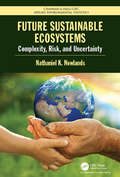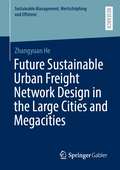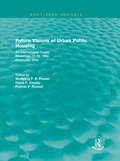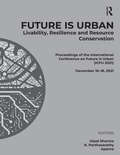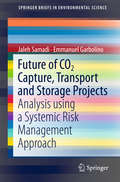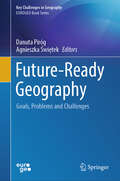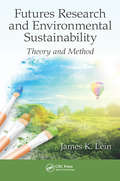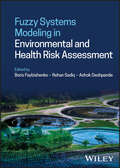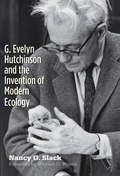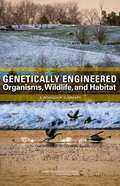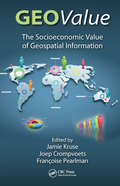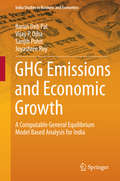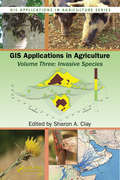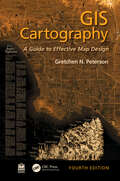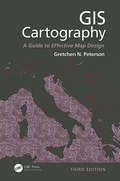- Table View
- List View
Future Sea: How to Rescue and Protect the World’s Oceans
by Deborah Rowan WrightA counterintuitive and compelling argument that existing laws already protect the entirety of our oceans—and a call to understand and enforce those protections. The world’s oceans face multiple threats: the effects of climate change, pollution, overfishing, plastic waste, and more. Confronted with the immensity of these challenges and of the oceans themselves, we might wonder what more can be done to stop their decline and better protect the sea and marine life. Such widespread environmental threats call for a simple but significant shift in reasoning to bring about long-overdue, elemental change in the way we use ocean resources. In Future Sea, ocean advocate and marine-policy researcher Deborah Rowan Wright provides the tools for that shift. Questioning the underlying philosophy of established ocean conservation approaches, Rowan Wright lays out a radical alternative: a bold and far-reaching strategy of 100 percent ocean protection that would put an end to destructive industrial activities, better safeguard marine biodiversity, and enable ocean wildlife to return and thrive along coasts and in seas around the globe. Future Sea is essentially concerned with the solutions and not the problems. Rowan Wright shines a light on existing international laws intended to keep marine environments safe that could underpin this new strategy. She gathers inspiring stories of communities and countries using ocean resources wisely, as well as of successful conservation projects, to build up a cautiously optimistic picture of the future for our oceans—counteracting all-too-prevalent reports of doom and gloom. A passionate, sweeping, and personal account, Future Sea not only argues for systemic change in how we manage what we do in the sea but also describes steps that anyone, from children to political leaders (or indeed, any reader of the book), can take toward safeguarding the oceans and their extraordinary wildlife.
Future Security of the Global Arctic: State Policy, Economic Security And Climate
by Lassi HeininenIn the globalized Arctic there has been a transformation from military security to human security. Climate change, the utilization of Arctic resources and other global challenges have caused the Arctic 'paradox' and a need to redefine security.
Future Sustainable Ecosystems: Complexity, Risk, and Uncertainty (Chapman & Hall/CRC Applied Environmental Statistics #11)
by Nathaniel K NewlandsFuture Sustainable Ecosystems: Complexity, Risk, Uncertainty provides an interdisciplinary, integrative overview of environmental problem-solving using statistics. It shows how statistics can be used to solve diverse environmental and socio-economic problems involving food, water, energy scarcity, and climate change risks. It synthesizes interdisciplinary theory, concepts, definitions, models and findings involved in complex global sustainability problem-solving, making it an essential guide and reference. It includes real-world examples and applications making the book accessible to a broader interdisciplinary readership. Discussions include a broad, integrated perspective on sustainability, integrated risk, multi-scale changes and impacts taking place within ecosystems worldwide. State-of-the-art statistical techniques, including Bayesian hierarchical, spatio-temporal, agent-based and game-theoretic approaches are explored. The author then focuses on the real-world integration of observational and experimental data and its use within statistical models.
Future Sustainable Urban Freight Network Design in the Large Cities and Megacities (Sustainable Management, Wertschöpfung und Effizienz)
by Zhangyuan HeThis book aims to investigate a long-term strategy for sustainable urban logistics. The literature evidence exhibits that considerable research on urban logistics lacks long-term planning and rarely considers the urban spatial development and integration of urban distribution innovations. Currently, 11 distribution innovations can be used for future sustainable urban freight transport. According to a systematic discussion, this book formulates the conceptual model of Sustainable Inner-urban Intermodal Transportation (SIUIT) for future urban logistics. Moreover, a comprehensive analysis illustrates that future integrations of distribution innovations comprise operational and technological integration. To this end, the morphological analysis method is employed to discuss their feasible solutions based on the SIUIT model. After that, combined with the trend exploration of urban spatial development on large- and megacities, this book constructs the 2.x Modula & Sustainable Urban Freight Network to improve the flexibility of the future sustainable logistics transformation.About the AuthorDr. rer. pol. Zhangyuan He graduated from the University of Bremen. He currently undertakes postdoctoral research at the School of Urban Planning and Design, Peking University.
Future Visions of Urban Public Housing: An International Forum, November 17-20, 1994 (Routledge Revivals)
by Wolfgang F. Preiser David P. Varady Francis P. RussellFirst published in 1994, this book brings together the papers presented at the International Forum on ‘Future Visions of Urban Public Housing’ held on November 17-20, 1994 in Cincinnati, Ohio. Participants included public housing officials, academics, practitioners and public housing residents who came together to debate, compare and analyse practices and issues in urban and public housing in industrialised nations. The 55 collected papers address the following key topics: public housing policy; comprehensive neighbourhood planning for public housing; public housing in the urban design context; quality of design standards and guidelines for public housing; resident participation and enhanced self-sufficiency in public housing; public housing alternatives; revitalising and rehabilitating public housing; the Elderly, Children, and special populations in public housing. The findings suggest new directions for policy and agendas for action.
Future is Urban: Proceedings of the International Conference on FUTURE IS URBAN: Livability, Resilience and Resource Conservation (ICFU 2021), December 16–18, 2021
by R. Parthasarathy Utpal SharmaCities have played an important role in our lives since the dawn of civilization. However, cities are slowly becoming overwhelmed and therefore intervention is desirable towards green, blue and egalitarian nature. Even with current urban issues, we must rise to the occasion as professionals to create cities that are social, cities that take care of the environment, and cities that are digital. Increased citizen participation is indispensable in this process. The ‘International Conference on Future is Urban (IFCU’ 21) Dec 16-18, 2021, Ahmedabad, India’, takes into account Livability, Resilience & Resource Conservation for planning Future and cities in future.
Future of CO2 Capture, Transport and Storage Projects: Analysis Using A Systemic Risk Management Approach (SpringerBriefs in Environmental Science)
by Emmanuel Garbolino Jaleh SamadiThis book presents a summary of a three-year research project on risk management for the Capture, Transport and Storage of CO2 (CTSC), offering an in-depth study on complex sociotechnical systems and systemic modeling. Approaching CTSC as a complex sociotechnical system, this book proposes systemic modeling as a decision-making aid. It offers a means of decision-making for the development of CTSC projects in the real-world context, where the future of the technology is uncertain. Risk management is considered as a means of control that can provide a control structure for the whole system.The risks associated with CTSC are not exclusively technical in nature; CTSC also faces a number of further uncertainties, from development to commercial scales.A major question concerning CTSC at the current scale of development is: "What are the factors explaining the success or failure of CTSC projects in different contexts?" In order to answer this question, the book proposes a systemic risk management framework based on the system dynamics and STAMP (Systems-Theoretic Accident Model and Processes) concepts.
Future-Ready Geography: Goals, Problems and Challenges (Key Challenges in Geography)
by Danuta Piróg Agnieszka ŚwiętekThis book presents research on how geography as a science, as a university degree and as a school subject can get ready for the “future.” Today's world is in a state of permanent and radical change which is affecting society, science and the economy in equal measure. The concurrent processes of globalisation, digitisation, and integration shape and constantly modify the development factors and generate multidirectional social changes. Growing global issues related to climate change, food security, depletion of conventional energy sources, conflicts and wars, refugee crisis and pandemic open up new issues for geographic investigations as well as reinforce the need to examine old research topics covering a variety of subdisciplines. That is why the term “future-ready” is being more frequently used in discourses on geographic research. In particular, geographic education at schools should be subject to discussion and reflection as this is where our learners are primed to understand the world around them. The chapters of this book spread the knowledge about the role of geography in preparing the society for the future. The book responds to environmental, socio-economic, and political issues of global, regional and local impact. It provides methods, techniques and tools of data collection and analysis which efficiently support geographers in future-oriented research and help in forecasting environmental and social changes. Finally, this volume also discusses how to reinforce the position of geography as science and school subject today and in the future.
Future-proofing Travel: How to Create a Resilient and Sustainable Industry
by Caroline BremnerEvolving traveller expectations, pressures to reduce emissions and a need to preserve popular destinations from over-tourism and climate change are creating untold disruption in the travel industry. The industry cannot continue to grow unchecked and wholesale transformation is required.Future-proofing Travel considers current travel trends in consumer expectations for greener and more experiential travel alongside the demands from local communities and industry-led initiatives to meet government pledges of lower emissions. It explores how business leaders in tourism and hospitality services must adapt their offerings to remain relevant in a competitive environment where sustainability and technology are no longer nice-to-haves. Explore data-driven and holistic solutions for travel industry professionals to transform their businesses to be more purposeful and sustainable with this book.While there is no one pathway to success, Future-proofing Travel shows how travel companies and destinations are currently adapting their practices to be more impact conscious while also elevating the traveller experience. Using real-world examples from leading brands such as Airbnb, Marriott, TUI and Intrepid Travel, this book maps out how travel brands and destinations can accelerate their positive actions through digitalization and green innovation to regenerate local communities, retain consumer loyalty and increase long-term profits sustainably into the future.
Futures Research and Environmental Sustainability: Theory and Method
by James K. LeinThis book explores the challenges of presenting sustainability as a more actionable or practical concept and identifying approaches that might offer useful assistance in addressing the temporal and spatial representation of sustainability. The underlying premise of this book is that sustainability is a state realized in the future. In that future there is a geographic arrangement of society and economy that agrees with its environmental setting. This future perspective introduces a little examined subject area that can lend significant content to the sustainability challenge: Futures Research.
Futures after Progress: Hope and Doubt in Late Industrial Baltimore
by Chloe AhmannA powerful ethnographic study of South Baltimore, a place haunted by toxic pasts in its pursuit of better futures. Factory fires, chemical explosions, and aerial pollutants have inexorably shaped South Baltimore into one of the most polluted places in the country. In Futures after Progress, anthropologist Chloe Ahmann explores the rise and fall of industrial lifeways on this edge of the city and the uncertainties that linger in their wake. Writing from the community of Curtis Bay, where two hundred years of technocratic hubris have carried lethal costs, Ahmann also follows local efforts to realize a good future after industry and the rifts competing visions opened between neighbors. Examining tensions between White and Black residents, environmental activists and industrial enthusiasts, local elders and younger generations, Ahmann shows how this community has become a battleground for competing political futures whose stakes reverberate beyond its six square miles in a present after progress has lost steam. And yet—as one young resident explains—“that’s not how the story ends.” Rigorous and moving, Futures after Progress probes the deep roots of our ecological predicament, offering insight into what lies ahead for a country beset by dreams deferred and a planet on the precipice of change.
Futures: Imagining Socioecological Transformation
by Bruce BraunFutures: Imagining Socioecological Transformation brings together leading scholars to explore how we might know, enact, and struggle for, the conjoined social and ecological transformations we need to achieve just and sustainable futures. The question of transformation, and how it might be achieved, is explored across a variety of topics and geographical sites, and through heterodox analytical and theoretical approaches, in a collective effort to move beyond a form of critique that hands down judgements, to one that brings new ideas and new possibilities to life. Chapters are lively and original engagements with concrete situations that sparkle with creativity. Together, they add up to an impressive study of how to live, and what to struggle for, in the complex socioecological landscapes of the Anthropocene. This book was previously published as a special issue of the Annals of the Association of American Geographers.
Futurize! Dealing with Megatrends and Disruptors: A Handbook for the Future-Oriented CEO
by André de Waal Julie LinthorstThe future will bring only more megatrends and disruptions. With the guidance of this book, which centers around the authors’ years-of-research-backed high-performance organizations (HPO) framework and includes the unique self-assessment tool Futurize! Diagnosis, business leaders and organizations will be prepared and truly ‘future ready.’ The next two decades will present massive challenges for organizations, as they navigate the need for sustainable development against a complex backdrop of factors such as increasing inequality, resource scarcity, continued globalization, and the ever-increasing speed of technological advancement. This book will help business leaders and organizations set priorities and make decisions so that not only do they honor commitments to the United Nations Sustainable Development Goals, but also become more future ready by: identifying the megatrends and disruptors which impact organizations now and will in the future specifically outlining how those megatrends and disruptors will impact organizations showing how organizations can deal with this impact in practical terms. This book is a must for management teams, aspiring leaders, and professionals and students interested in the future of work, human resource management, and innovation.
Fuzzy Systems Modeling in Environmental and Health Risk Assessment (Water Resources Monograph)
by Boris Faybishenko Ashok Deshpande Rehan SadiqFuzzy Systems Modeling in Environmental and Health Risk Assessment Demonstrates the successful application of fuzzy systems modeling to real-world environmental and health problems In Fuzzy Systems Modeling in Environmental and Health Risk Assessment, a team of distinguished researchers delivers an up-to-date collection of the most successful and innovative attempts to apply fuzzy logic to problems involving environmental risk assessment, healthcare decision-making, the management of water distribution networks, and the optimization of water treatment and waste management systems. By explaining both the theoretical and practical aspects of using fuzzy systems modeling methods to solve complex problems, analyze risks and optimize system performance, this handy guide maintains a strongly application-oriented perspective throughout, offering readers a practical treatment of a cutting-edge subject. Readers will also find: Comprehensive explorations of the practical applications of fuzzy systems modeling in environmental science Practical advice on environmental quality assessments and human health risk analyses In-depth case studies involving air and water pollution, solid waste, indoor swimming pool and landfill risk assessments, wastewater treatment, and more Perfect for environmental engineers and scientists, Fuzzy Systems Modeling in Environmental and Health Risk Assessment will also benefit policy makers, computer scientists, mathematicians, and researchers and practitioners interested in applying soft computing theories to environmental problems.
Fy Nodiadau Adolygu: CBAC UG/Safon Uwch Daearyddiaeth My Revision Notes: WJEC/Eduqas AS/A-level Geography Welsh-language edition)
by Kevin DavisTarget success in WJEC and WJEC Eduqas AS/A-level Geography with this proven formula for effective, structured revision.Key content coverage is combined with exam-style tasks and practical tips to create a revision guide that students can rely on to review, strengthen and test their knowledge.With My Revision Notes every student can:- Plan and manage a successful revision programme using the topic-by-topic planner- Consolidate subject knowledge by working through clear and focused content coverage- Test understanding and identify areas for improvement with regular 'Now Test Yourself' tasks and answers- Enhance exam responses using relevant examples and case studies for each topic- Improve exam technique through practice questions, expert tips and examples of typical mistakes to avoidThis revision guide covers the following topics:- Changing landscapes (Coastal landscapes; Glaciated landscapes)- Changing places- Global systems (Water and carbon cycles)- Global governance (Processes and patterns of global migration; Global governance of the Earth's oceans)- Contemporary themes in geography (Tectonic hazards)It also includes exam questions for 21st century challenges.This revision guide is suitable for the following specifications:- 2016 WJEC AS/A-level Geography specification regulated by Qualifications Wales- 2016 WJEC Eduqas AS/A-level Geography specification regulated by OfqualPlease note this is a Welsh language edition.
Fy Nodiadau Adolygu: CBAC UG/Safon Uwch Daearyddiaeth My Revision Notes: WJEC/Eduqas AS/A-level Geography Welsh-language edition) (MRN)
by Kevin DavisTarget success in WJEC and WJEC Eduqas AS/A-level Geography with this proven formula for effective, structured revision.Key content coverage is combined with exam-style tasks and practical tips to create a revision guide that students can rely on to review, strengthen and test their knowledge.With My Revision Notes every student can:- Plan and manage a successful revision programme using the topic-by-topic planner- Consolidate subject knowledge by working through clear and focused content coverage- Test understanding and identify areas for improvement with regular 'Now Test Yourself' tasks and answers- Enhance exam responses using relevant examples and case studies for each topic- Improve exam technique through practice questions, expert tips and examples of typical mistakes to avoidThis revision guide covers the following topics:- Changing landscapes (Coastal landscapes; Glaciated landscapes)- Changing places- Global systems (Water and carbon cycles)- Global governance (Processes and patterns of global migration; Global governance of the Earth's oceans)- Contemporary themes in geography (Tectonic hazards)It also includes exam questions for 21st century challenges.This revision guide is suitable for the following specifications:- 2016 WJEC AS/A-level Geography specification regulated by Qualifications Wales- 2016 WJEC Eduqas AS/A-level Geography specification regulated by OfqualPlease note this is a Welsh language edition.
Führung und Personal in der Polizei: Empirische Studien (Schriftenreihe zur Polizei- und Sicherheitsforschung)
by Rolf Ritsert Antonio VeraDieses Buch enthält drei quantitative und drei qualitative empirische Studien, die sich mit den aktuellen Herausforderungen im Themenfeld Führung und Personal in der Polizei beschäftigen. Im Mittelpunkt stehen Themen wie transformationale Führung, Value Based Leadership, Führungsmotivation und Recruiting. Die Autorinnen und Autoren kombinieren dabei akademisches Know-how mit polizeilichem Erfahrungswissen und versuchen, wissenschaftlich solide und zugleich praxisrelevante Erklärungs- und Lösungsansätze für die vielfältigen Probleme in diesem Bereich zu finden. Die Zielgruppe besteht folglich aus Praktikern und Wissenschaftlern im Bereich des Polizeimanagements.
G. Evelyn Hutchinson and the Invention of Modern Ecology
by Nancy G. SlackStephen J. Gould declared G. Evelyn Hutchinson the most important ecologist of the twentieth century. E.O. Wilson pronounced him "one of the few scientists who could unabashedly be called a genius." In this fascinating book, Nancy G. Slack presents for the first time the full life story of this brilliant scientist who was also a master teacher, a polymath, and a delightful friend and correspondent. Based on full access to Hutchinson's archives and extensive interviews with him and many who knew him, the author evaluates his important contributions to modern ecology and his profound influence as a mentor. Filled with information available nowhere else, the book draws a vibrant portrait of an original scientific thinker who was also a man of remarkable personal appeal.
GED Test Prep Flash Cards: Earth Science (Exambusters GED Workbook #1 of 13)
by Ace Inc.<P><P><i>Advisory: Bookshare has learned that this book offers only partial accessibility. We have kept it in the collection because it is useful for some of our members. Benetech is actively working on projects to improve accessibility issues such as these.</i><P><P> 600 questions. Topics: Earth's Origin, Minerals, Rocks, Weathering, Wind and Glaciers, Oceans, Maps, Atmosphere, Astronomy <P><P> EXAMBUSTERS GED Prep Workbooks provide comprehensive, fundamental GED review--one fact at a time--to prepare students to take practice GED tests. Each GED study guide focuses on one specific subject area covered on the GED exam. From 300 to 600 questions and answers, each volume in the GED series is a quick and easy, focused read. Reviewing GED flash cards is the first step toward more confident GED preparation and ultimately, higher GED exam scores!
GENETICALLY ENGINEERED Organisms, Wildlife, and Habitat: A WORKSHOP SUMMARY
by National Research Council of the National AcademiesSince the first commercial introduction of transgenic corn plants in 1995, biotechnology has provided enormous benefits to agricultural crop production. Research is underway to develop a much broader range of genetically engineered organisms (GEOs), including fish, trees, microbes, and insects, that could have the potential to transform fields such as aquaculture, biofuels production, bioremediation, biocontrol, and even the production of pharmaceuticals . However, biotechnology is not without risk and continues to be an extremely controversial topic. Chief among the concerns is the potential ecological effects of GEOs that interact with wildlife and habitats. The U.S. Geological Survey (USGS) is charged with providing scientific advice to inform federal agencies that manage wildlife and their habitats. USGS has identified biotechnology as one of its major challenges for future research. Seeing an opportunity to initiate a dialogue between ecologists and developers of GEOs about this challenge, the USGS and the National Research Council (NRC) held a two-day workshop in November of 2007, to identify research activities with the greatest potential to provide the information needed to assess the ecological effects of GEOs on wildlife and habitats. The workshop, designed to approach the research questions from a habitat, rather than transgenic organism, perspective, is summarized in this book.
GEOValue: The Socioeconomic Value of Geospatial Information
by Joep Crompvoets Jamie B. Kruse Francoise PearlmanQuantifying the social and economic value that geospatial information contributes to modern society is a complex task. To construct reliable and consistent valuation measures requires an understanding of the sequence of processes that starts with data acquisition, and leads to decision-makers’ choices that impact society. GEOValue explores each step in this complex value chain from the viewpoint of domain experts spanning disciplines that range from the technical side of data acquisition and management to the social sciences that provide the framework to assess the benefit to society. The book is intended to provide foundational understanding of the techniques and complexities of each step in the process. As such it is intended to be assessable to a reader without prior training in data acquisition systems, information systems, or valuation methods. In addition, a number of case studies are provided that demonstrate the use of geospatial information as a critical input for evaluation of policy pertaining to a wide range of application areas, such as agricultural and environmental policy, natural catastrophes, e-government and transportation systems.
GHG Emissions and Economic Growth
by Sanjib Pohit Barun Deb Pal Vijay P. Ojha Joyashree RoyIssues linking climate change and economic growth are now at the centre of discussions regarding development strategies especially in the context of developing countries. This book contributes by analyzing the relationship between economic growth and GHG emissions in India with explicit reference to all major economic sectors. One of the most popular tools for macroeconomic policy analysis is Social Accounting Matrix (SAM). The book presents the methods and estimates of the latest Social Accounting Matrix (SAM) for India, which provides a major data base describing the complete circular flow of income and input-output transactions among the sectors of the economy. The novelty of the book lies in the fact that for the first time a SAM has been prepared for the Indian economy with environmental indicators. A detailed methodology for constructing such an extended SAM is also presented in the book. The environmental social accounting matrix (ESAM) based analysis has been included to show direct and indirect links between economic growth and GHG emissions. The book also includes analysis of factors affecting historical GHG emissions trends in India. The book goes beyond SAM and applies computable general equilibrium (CGE) modelling to derive climate-change policy analysis and simulations. This CGE-based analysis is an important contribution to the current debate surrounding carbon tax and its possible impact on macroeconomic growth.
GIS Applications in Agriculture, Volume Three: Invasive Species (GIS Applications in Agriculture)
by Sharon A. ClayWhile many "alien" plant and animal species are purposefully introduced into new areas as ornamentals, livestock, crops, and even pets, these species can escape into other areas and threaten agricultural and native ecosystems causing economic and environmental harm, or harm to human health. Increasingly, scientists are using Geographic Information Systems (GIS) to track and manage the invaders, mitigate the potential rate of spread and level of impact, and protect the native economy and ecosystem.Beginning with an introduction to the use of GIS technology to capture, store, analyze, manage, and present data, GIS Applications in Agriculture, Volume Three: Invasive Species examines five relevant categories of geographic information including dispersal and transport, prediction and forecasting, mapping of current infestations, maps for management and control tactics, and impact assessment and method of control. It address GIS for studying the population ecology of a new species, niche requirements for species success, and the monitoring and control of several different species including Australian examples of intentionally introduced invasive species, insects and other animals that may also vector a disease, and invasive weed management from prediction to management. Chapters cover maps and imageries available on various Web sites and provide step-by-step tutorials or case studies that allow manipulation of datasets featured on the accompanyingdownloadable resources to make maps, perform statistical analyses, and predict future problems. It offers hands-on experience with a variety of software programs that create interactive queries (user-created searches), analyze spatial information, edit data and maps, and present the results of these operations in several different formats. Some of the programs are freeware, others are not, but each can be used to integrate, edit, share, and display geographic information. Color figures are
GIS Cartography: A Guide to Effective Map Design
by Gretchen N. PetersonThe new edition of this well-established introductory cartography textbook is updated to respond to the demand for critical engagement with new technologies, the passion for inclusive design, and for preparing students to build competence in fundamental skills. Written in a friendly style, it is enjoyable to read and includes over 200 figures and maps, explaining everything from layout design to dynamic cartography issues. A new chapter discusses the role of artificial intelligence (AI) in cartography, and a significant expansion to 3D cartography has been incorporated into existing chapters. A new chapter on accessibility provides a thorough understanding of universal design. Additional updates include placements and best practices for digital map elements, global labeling techniques including language support, hybrid map styling, multiscale map testing, and information on 4D mapping.New in the Fourth Edition: Exploration of geospatial AI and generative AI in cartography and how they can already make an impact on workflows. New material on vision, motor, and cognitive accessibility techniques in map design. Expanded discussion on 3D cartography. All chapters are updated with new data and important new developments in cartography, including the importance of accessible design to ensure inclusivity for all users. Updated study questions and exercises to enhance student engagement and comprehension. New discussions of techniques such as aquarium cutaways, integrated north arrows, joy plots, hybrid satellite maps, crafted hachuring, as well as updated information on resolution and file types. This book is written as a go-to guide for learning the art and science of mapmaking. It is for undergraduate and graduate students taking courses in GIS and cartography and studying fields such as geography, geophysics, environmental engineering, urban planning, and so on. It is also a valuable resource for professionals interested in learning techniques and technologies for creating maps and visualizing geospatial datasets.
GIS Cartography: A Guide to Effective Map Design, Third Edition
by Gretchen N. PetersonSince the publication of the bestselling second edition 5 years ago, vast and new globally-relevant geographic datasets have become available to cartography practitioners, and with this has come the need for new ways to visualize them in maps as well as new challenges in ethically disseminating the visualizations. With new features and significant updates that address these changes, this edition remains faithful to the original vision that cartography instruction should be software agnostic. Discussing map design theory and technique rather than map design tools, this book focuses on digital cartography and its best practices. This third edition has completely new sections on how to deal with maps that go viral and the ethics therein; new presentation ideas; new features such as amenities, climate data, and hazards; the new Equal Earth projection; and vector tile design considerations. All chapters are thoroughly updated with new illustrations and new sections for datasets that didn’t exist when the second edition was published, as well as new techniques and trends in cartography. New in the third edition: A true textbook, written with a friendly style and excellent examples explaining everything from layout design to fonts and colors, to specific design considerations for individual feature types, to static and dynamic cartography issues. Thoroughly updated with new features such as points of interest, climate data, hazards, and buildings; new projections such as the Equal Earth projection and the Spilhaus projection; and vector tile design considerations such as label placement techniques and tricks for making world-class basemaps. Includes over 70 new map examples that display the latest techniques in cartography. Reflects on new developments in color palettes; visualization patterns; datums; and non-static output media such as animation, interaction, and large-format cinematic techniques that weren’t available for the second edition. Defines and illustrates new terms that have made their way into the profession over the last few years such as story maps, flow maps, Dorling cartograms, spec sheets, bivariate choropleths, firefly cartography, Tanaka contours, and value-by-alpha. In this third edition, author Gretchen Peterson takes a "don’t let the technology get in the way" approach to the presentation, focusing on the elements of good design, what makes a good map, and how to get there, rather than specific software tools. She provides a reference that you can thumb through time and again as you create your maps. Copiously illustrated, the third edition explores novel concepts that kick-start your pursuit of map-making excellence. The book doesn’t just teach you how to design and create good maps, it teaches you how to design and create superior maps.


